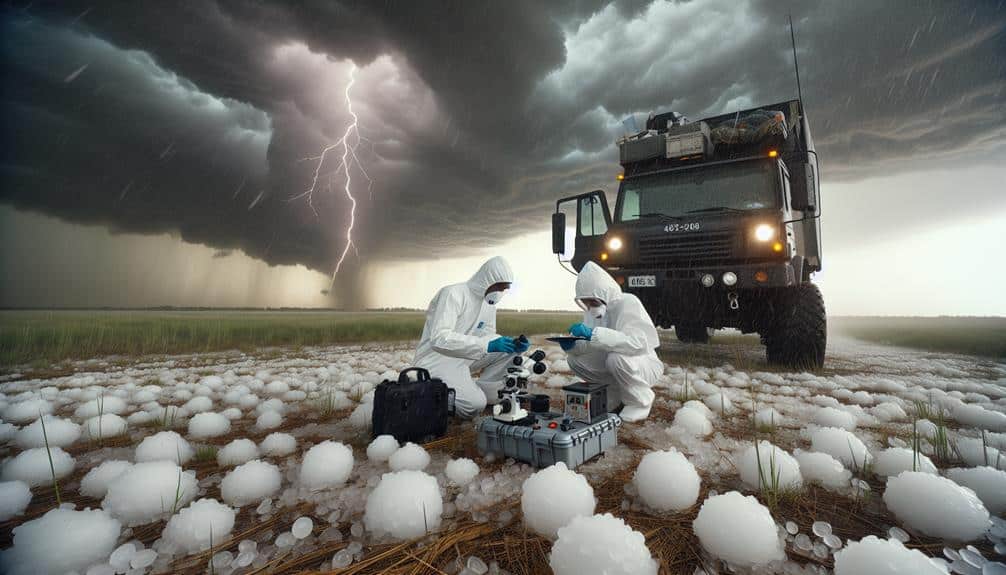Studying wildlife in hailstorms demands a detailed approach to guarantee both researcher safety and the integrity of collected data. First, we must prioritize safety by conducting risk assessments, planning secure shelters, and practicing evacuation drills. Equipping ourselves with waterproof, insulated gear and emergency plans is essential. Utilizing remote monitoring tools like GPS collars and weather-resistant sensors allows for continuous data collection without endangering researchers. Documenting behavioral changes through pre- and post-storm data sheds light on wildlife responses. Finally, collaborating with climate experts and data analysts enriches our findings and predictive capabilities. For a deeper understanding, let's explore each practice in detail.
Key Points
- Conduct detailed risk assessments to identify potential hazards and plan safe evacuation routes.
- Equip researchers with protective clothing and waterproof gear to ensure safety and data security.
- Utilize remote monitoring devices to collect continuous data and minimize human presence during storms.
- Integrate weather tracking with high-resolution cameras to document wildlife behavioral changes pre- and post-hailstorm.
Prioritize Safety Measures
Safeguarding the safety of both researchers and wildlife is paramount when conducting studies during hailstorms. To achieve this, we need to establish thorough emergency protocols and effective communication channels.
Our first step is to conduct a detailed risk assessment. By evaluating potential hazards, we can anticipate the impact of severe weather and prepare accordingly. This includes identifying secure locations for shelter and determining the safest routes for evacuation.
Communication is critical in these situations. We must make sure that all team members are equipped with reliable communication devices. Regular check-ins and updates should be scheduled to maintain situational awareness and coordinate actions. Clear, predefined signals and codes can streamline communication when time is of the essence.
An evacuation plan is indispensable. We should map out multiple escape routes and designate specific roles for each team member. Everyone must be familiar with the plan and practice it regularly through drills. This preparation ensures that in the event of a hailstorm, we can act swiftly and effectively, minimizing risk to both humans and animals.
Equip Proper Gear
In order to conduct effective wildlife studies during hailstorms, we must equip ourselves with specialized gear that not only protects us from the elements but also secures the integrity of our data collection.
First and foremost, protective clothing is essential. We need to wear insulated, waterproof jackets, pants, and sturdy boots to make sure we stay dry and warm. This gear helps prevent hypothermia and other weather-related health risks.
Waterproof equipment is equally important to safeguard our instruments. Cameras, GPS devices, and notebooks should be housed in waterproof cases. Securing that our tools remain functional and that data isn't lost or corrupted is critical for the success of our study.
In addition to protective gear, we must have clear emergency plans and shelter options. Establishing pre-determined safe zones where we can quickly take refuge if the hailstorm intensifies will protect us from injury. Portable shelters or nearby vehicles can serve as immediate shelters, providing a secure environment to wait out the storm.
Use Remote Monitoring
Leveraging remote monitoring techniques allows us to collect wildlife data during hailstorms while minimizing risk to researchers. This approach harnesses technology advancements to secure our safety and maintain the integrity of data collection. By deploying remote cameras, GPS collars, and weather-resistant sensors, we can continuously observe animal behaviors without physical presence in hazardous conditions.
Remote monitoring offers several compelling benefits:
- Safety First: Defends researchers from the dangers of extreme weather.
- Uninterrupted Data: Secures continuous data collection even when storms make field access impossible.
- Behavioral Insights: Captures natural wildlife behavior unaffected by human presence.
- Cost Efficiency: Reduces the need for frequent, expensive field expeditions.
Using these technologies, we can deploy cameras and sensors in strategic locations before hailstorms hit. These devices can withstand harsh conditions, providing us with real-time data on wildlife responses to extreme weather.
Additionally, GPS collars help track animal movements, offering insights into migration patterns and habitat use during and after storms.
Remote monitoring not only enhances our research capabilities but also aligns with our pursuit of freedom from conventional fieldwork constraints. By embracing these advancements, we can safely and effectively study wildlife in their natural, albeit stormy, environments.
Document Behavioral Changes
To document behavioral changes, we meticulously analyze the data collected from remote monitoring devices to identify patterns and anomalies in wildlife activities during hailstorms. Our approach entails integrating weather tracking systems with high-resolution cameras and GPS collars to capture real-time data. This allows us to correlate specific weather events, such as the onset and intensity of hailstorms, with alterations in wildlife behavior.
We employ rigorous data analysis techniques to interpret the collected information. By comparing pre-storm, storm, and post-storm data, we can discern significant behavioral modifications. For instance, we observe variations in movement patterns, feeding habits, and shelter-seeking behavior. These observations are pivotal in understanding how wildlife adapts to extreme weather conditions, which could inform conservation strategies and habitat management plans.
Our findings indicate that certain species exhibit heightened alertness and reduced activity levels during hailstorms, possibly as a survival mechanism. By utilizing weather tracking data, we can predict these behavioral shifts with greater accuracy. This predictive capability enhances our ability to forecast wildlife responses to future hailstorms, ultimately contributing to more effective wildlife protection measures.
Our ongoing research aims to refine these methods, enabling us to better understand and mitigate the impact of severe weather on wildlife.
Collaborate With Experts

Partnering with climate experts, wildlife researchers, and data analysts, we guarantee our research on wildlife behavior during hailstorms is strong and interdisciplinary. Through these research partnerships, we leverage diverse expertise to build a thorough understanding of how wildlife adapts to extreme weather events.
Field observations are essential, but they only provide part of the picture. By collaborating with experts from various disciplines, we enrich our data analysis with advanced modeling and predictive analytics.
To illustrate the power of collaboration:
- Climate experts help us predict hailstorms with greater accuracy, allowing us to plan fieldwork more effectively.
- Wildlife specialists provide insights into species-specific behaviors, ensuring our observations are relevant and meaningful.
- Data analysts enhance our ability to process and interpret large datasets, revealing patterns we might otherwise miss.
- Animal biologists offer expertise in animal tracking and monitoring, essential for understanding movement and habitat use.
This interdisciplinary approach guarantees we capture the full scope of wildlife responses to hailstorms. By integrating field observations with expert insight, we produce well-rounded, actionable findings.
Our commitment to collaboration not only strengthens our research but also fosters a community of shared knowledge and innovation.
Frequently Asked Questions
How Do Hailstorms Affect the Migration Patterns of Wildlife?
Ever wondered how hailstorms impact migration patterns? They cause behavioral changes and habitat disruptions. Wildlife adapts by altering migration routes, driven by climate impacts. Understanding these changes, we gain insights into the resilience and freedom of nature.
What Are the Legal Considerations for Studying Wildlife During Extreme Weather Events?
When studying wildlife during extreme weather events, we must consider legal implications and ethical concerns. Ensuring compliance with regulations and prioritizing animal welfare are vital for conducting responsible and respectful research. Freedom in research demands accountability.
How Can Citizen Science Contribute to Hailstorm Wildlife Studies?
With 70% of biodiversity data coming from citizen science, we can boost community engagement and data collection. Our monitoring programs thrive on volunteer involvement, ensuring we gather extensive wildlife information even during hailstorms. Let's contribute together.
What Funding Opportunities Exist for Research on Wildlife in Hailstorms?
Let's explore available research grants and scholarships for our study. We can secure funding for fieldwork and equipment through organizations like the National Science Foundation and wildlife conservation groups. These resources will advance our scientific objectives.
How Do Different Species Adapt to the Sudden Temperature Changes During Hailstorms?
We observe that different species adapt to sudden temperature changes during hailstorms through behavioral changes like seeking shelter and physiological responses such as altering blood flow. These strategies secure survival in extreme conditions, enabling freedom.


